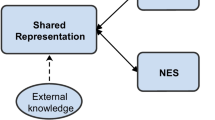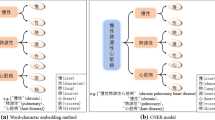Abstract
Named entity recognition (NER) for specialty domain is a challenging task since the labels are specific and there are not sufficient labelled data for training. In this paper, we propose a simple but effective method, named Light Transfer NER model (LTN), to tackle this problem. Different with most traditional methods that fine tune the network or reconstruct its probing layer, we design an additional part over a general NER network for new labels in the specific task. By this way, on the one hand, we can reuse the knowledge learned in the general NER task as much as possible, from the granular elements for combining inputs, to higher level embedding of outputs. On the other hand, the model can be easily adapted to the domain specific NER task without reconstruction. We also adopt the linear combination on each dimension of input feature vectors instead of using vector concatenation, which reduces about half parameters in the forward levels of network and makes the transfer light. We compare our model with other state-of-the-art NER models on real datasets against different quantity of labelled data. The experimental results show that our model is consistently superior than baseline methods on both effectiveness and efficiency, especially in case of low-resource data for specialty domain.
Access this chapter
Tax calculation will be finalised at checkout
Purchases are for personal use only
Similar content being viewed by others
References
Chung, J., Gülçehre, Ç., Cho, K., Bengio, Y.: Empirical evaluation of gated recurrent neural networks on sequence modeling. CoRR abs/1412.3555 (2014)
Collobert, R., Weston, J., Bottou, L., Karlen, M., Kavukcuoglu, K., Kuksa, P.: Natural language processing (almost) from scratch. JMLR 12, 2493–2537 (2011)
Devlin, J., Chang, M., Lee, K., Toutanova, K.: BERT: pre-training of deep bidirectional transformers for language understanding. CoRR abs/1810.04805 (2018)
Hammerton, J.: Named entity recognition with long short-term memory. In: Proceedings of the Seventh Conference on Natural Language Learning at HLT-NAACL 2003, CONLL 2003, vol. 4, pp. 172–175. Association for Computational Linguistics, USA (2003)
Hanisch, D., Fundel, K., Mevissen, H.T., Zimmer, R., Fluck, J.: Prominer: rule-based protein and gene entity recognition. BMC Bioinform. 6, S14 (2005)
Hochreiter, S., Schmidhuber, J.: Long short-term memory. Neural Comput. 9(8), 1735–1780 (1997)
Huang, Z., Xu, W., Yu, K.: Bidirectional LSTM-CRF models for sequence tagging. CoRR abs/1508.01991 (2015)
Jia, C., Liang, X., Zhang, Y.: Cross-domain NER using cross-domain language modeling. In: ACL, pp. 2464–2474 (2019)
Jin, G., Chen, X.: The fourth international Chinese language processing bakeoff: Chinese word segmentation, named entity recognition and Chinese POS tagging. In: Proceedings of the Sixth SIGHAN Workshop on Chinese Language Processing (2008)
Kim, J.H., Woodl, P.: A rule-based named entity recognition system for speech input. In: ICSLP (2000)
Lafferty, J.D., McCallum, A., Pereira, F.C.N.: Conditional random fields: probabilistic models for segmenting and labeling sequence data. In: ICML, pp. 282–289 (2001)
Li, X., Feng, J., Meng, Y., Han, Q., Wu, F., Li, J.: A unified MRC framework for named entity recognition. In: Proceedings of the 58th Annual Meeting of the Association for Computational Linguistics, pp. 5849–5859. Association for Computational Linguistics (2020)
Li, X., Sun, X., Meng, Y., Liang, J., Wu, F., Li, J.: Dice loss for data-imbalanced NLP tasks. In: Proceedings of the 58th Annual Meeting of the Association for Computational Linguistics, pp. 465–476. Association for Computational Linguistics (2020)
Lin, B.Y., Lu, W.: Neural adaptation layers for cross-domain named entity recognition. In: EMNLP, pp. 2012–2022 (2018)
Ma, X., Hovy, E.: End-to-end sequence labeling via bi-directional LSTM-CNNS-CRF (2016). arXiv preprint arXiv:1603.01354
McCallum, A., Freitag, D., Pereira, F.C.N.: Maximum entropy Markov models for information extraction and segmentation. In: ICML, pp. 591–598 (2000)
Peng, N., Dredze, M.: Named entity recognition for Chinese social media with jointly trained embeddings. In: EMNLP, pp. 548–554 (2015)
Peters, M.E., et al.: Deep contextualized word representations. CoRR abs/1802.05365 (2018)
Wang, Z., et al.: Label-aware double transfer learning for cross-specialty medical named entity recognition. In: NAACL, pp. 1–15 (2018)
Zhang, Y., Yang, J.: Chinese NER using lattice LSTM. In: ACL, pp. 1554–1564 (2018)
Acknowledgement
This work was supported by the National Key R&D Program of China (2018YFC0831401), the Key R&D Program of Shandong Province (2019JZZY010107), the National Natural Science Foundation of China (91646119), the Major Project of NSF Shandong Province (ZR2018ZB0420), and the Key R&D Program of Shandong province (2017GGX10114). The scientific calculations in this paper have been done on the HPC Cloud Platform of Shandong University.
Author information
Authors and Affiliations
Corresponding author
Editor information
Editors and Affiliations
Rights and permissions
Copyright information
© 2021 Springer Nature Singapore Pte Ltd.
About this paper
Cite this paper
Wu, J., Liu, T., Sun, Y., Gong, B. (2021). A Light Transfer Model for Chinese Named Entity Recognition for Specialty Domain. In: Sun, Y., Liu, D., Liao, H., Fan, H., Gao, L. (eds) Computer Supported Cooperative Work and Social Computing. ChineseCSCW 2020. Communications in Computer and Information Science, vol 1330. Springer, Singapore. https://doi.org/10.1007/978-981-16-2540-4_38
Download citation
DOI: https://doi.org/10.1007/978-981-16-2540-4_38
Published:
Publisher Name: Springer, Singapore
Print ISBN: 978-981-16-2539-8
Online ISBN: 978-981-16-2540-4
eBook Packages: Computer ScienceComputer Science (R0)





